How many steps should Meme currency take to become a mainstream asset?
This article comes from DecentralisedThis article comes fromJohn , original author: Joel

, compiled by Odaily translator Katie Koo.
There are two factors that drive asset prices - liquidity and belief. Liquidity refers to the amount of capital available for buyers and sellers to enter or leave a market. Beliefs motivate buyers or sellers to take action, and narratives play an important role in shaping beliefs. When collective faith is shaken, there is often a rush to sell assets.
This article examines the on-chain data to understand who is trading the recently popular Meme assets, how much returns are being generated, and whether it is a good idea to invest a lot of money to buy Meme coins. Finally, I will also discuss how Meme coins can be more sustainable (do Bigger and stronger) express some personal views.
secondary title
Are New Meme Coins More Valuable Than "Old" Meme Coins?PEPE has risen more than 60 times in the past few weeks. As of this writing, PEPE has generated more transactions than Solana, Avalanche, Polygon, and even Dogecoin.
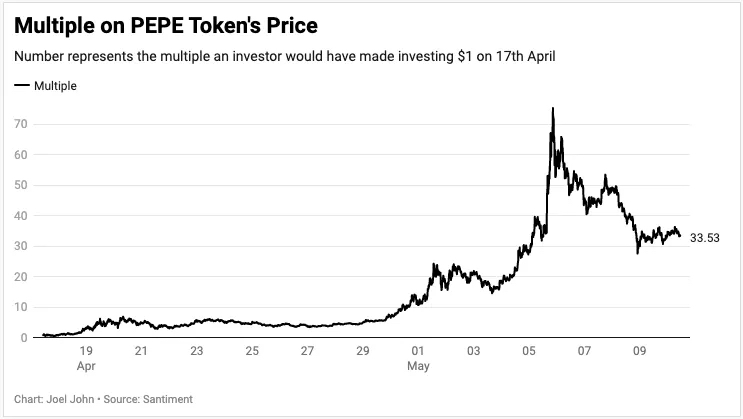
Is a new meme coin more valuable than an "old" meme coin? One way to assess the answer to this question is to examine the behavior of token holders.
According to Nansen, more than 100,000 unique wallets hold these meme assets. More than 1.4 million wallets hold "old" meme assets like Shiba Inu. The "Agreement" has struggled to achieve such results for many years. In terms of size, Aave and Compound each only have around 300,000 unique wallets holding their tokens. Part of the reason for this lower number is that many users likely hold these tokens on exchanges.
So initially you will see an increase in the number of wallets holding these assets because decentralized exchanges are the only place where users can get these assets. The flattening of the chart below around May 5th is because Binance listed the token at that time. Therefore, it is possible for traders to buy these tokens on centralized exchanges rather than through decentralized exchanges.Memecoins could be the trigger for a "massive destruction of value."
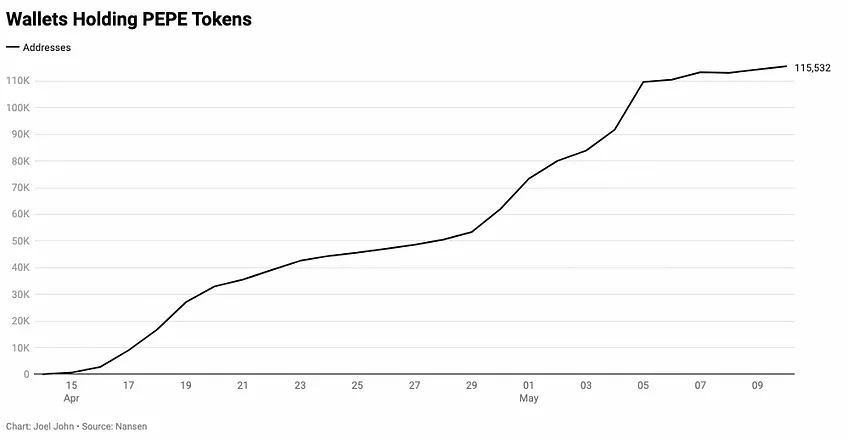
image description
Currently, more than 100,000 wallets hold PEPE.
One way to regulate meme coins is to force exchanges not to list them. But this only means that the sales of DEXs like Uniswap will increase. Even with a 0.1% fee, an exchange can make $1 million a day from meme coins, as the token is traded in the billions.
But why are retail investors buying these meme coins? Part of the reason is that Memecoin has "sudden wealth potential." Investing as little as $100 in PEPE will have the chance to generate a return of $6,000 at its peak. As a result, speculators often put a small amount of money into multiple memecoins, hoping to double it quickly. But the challenge for meme coins is that many of these assets trade without fundamental value, and price movements are entirely dependent on market sentiment and "vibes." Therefore, there will be many people competing to buy these assets, and they believe that other people will also buy, and they will become early holders if they start early. In a way, this is a classic example of greater fool theory.
(Odaily Note: The Big Fool Theory means that in the capital market, such as the stock and futures markets, the reason why people are willing to pay a high price for something regardless of its true value is because they expect a more stupid idiot to spend it. Buy it from them at a higher price. One of the most important truths the Great Fool Theory tells people is: In this world, being stupid is not terrible, what is terrible is being the last fool.)
In an environment of constant inflation, most things look like a Ponzi scheme. When a "wild" Memecoin is released, the DEX is its first place to trade.
Meme coins are often traded like Ponzi schemes because they work similarly. Initially, some early insiders bought tokens at very low prices. They contribute small amounts of USD to the liquidity pool and receive many "native tokens" in return. Essentially, they get a lot of tokens for just a few dollars.Once they reach a certain level of liquidity, meme assets like PEPE can persist for years.
secondary title
How did the Meme coin successfully "turn positive"?I used to think that memecoin would go to zero and then "crash the bottom".
But meme coins also have their own Lindy effect — the longer an asset is traded in the market, the more likely it is to stay in the market as long as it doesn’t claim to have some use. Dogecoin fits this description perfectly.

Most tokens issued by teams have several backers. Usually, these people are the founders, VCs, foundations, early employees behind the protocol, conversely, when a Memecoin is released, the early backers are the early adopters who buy tokens with USD.
Maybe you think I'm making up the Lindy effect, but if we look at the on-chain stats of past meme coins, you'll notice that meme coins in general end up netting a small number of early holders. The above chart is about the Shiba Inu.

Like last week's PEPE, it "exploded" in the 2021 narrative and hit new highs. There are wallets that made millions from an initial $1067 investment. Data from Nansen shows that the average realized profit and loss on the network over time is about 249%. The data looks pretty on the surface, unless you break down the net results by seller.
The graph above shows the distribution of returns for wallets trading Shiba Inu. The same token that makes someone who invests $1,000 a millionaire can make half of all traders realize their losses. From the data, only 6% of the wallets generated a large return of more than 600%. This is in 2021, the year Bitcoin went from a low of $20,000 to $64,000 (assuming you bought it in December 2019). So, unless you are one of the few examples of getting rich on Meme coins, the rewards are not justified relative to the risk you take on buying Meme coins early on.
Generally speaking, when exchanges list Meme coins, it has a Lindy effect. For example, about 23% of Shiba Inu is on exchanges. Dogelon's figure was about 33%. By handing over Meme coins to millions of retail investors, the exchanges have invested hundreds of dollars in them, and Meme coins have thus successfully "turned positive" and become formal financial products.Usually memecoin will perform better than Bitcoin or Ethereum, and every time the market rebounds, liquidity will flow to riskier assets during the market boom.For example, Musk understands the importance of producing memes for himself and his business, as shown in this iconic tweet below.
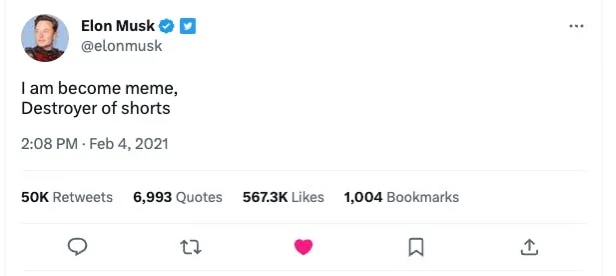
secondary title
The Possibility of Getting Rich with Meme Coins
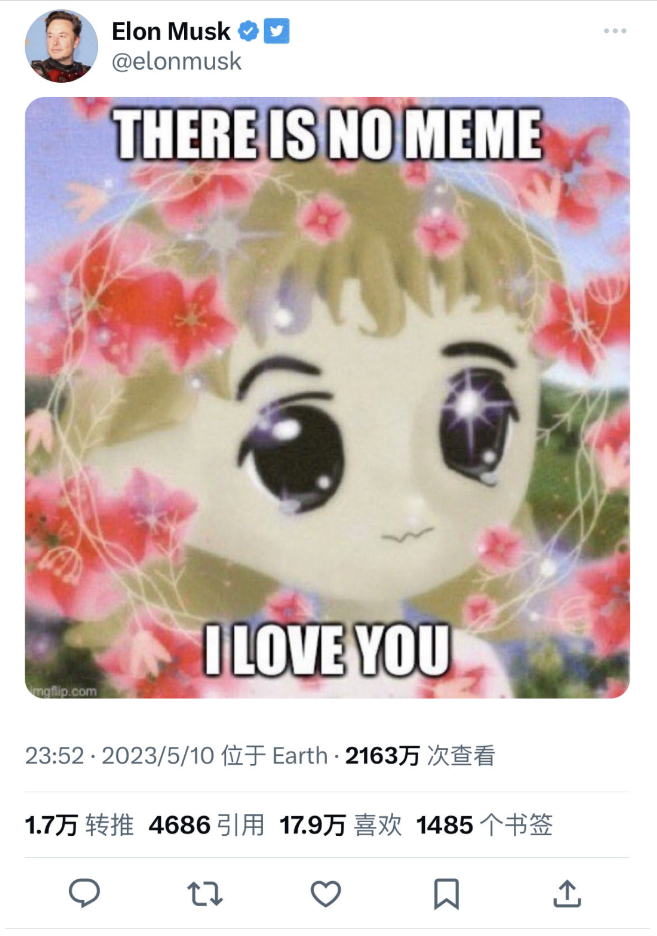
A bear market means assets are trading at deep discounts. The assumption is that the price will follow usage, and eventually, when usage grows to a point, the price of the asset is justified. When you buy JPEGs, the pixmaps you buy may gain relative value due to the "social influence" of other people who own the same asset. For example, the price of Miladys NFT soared because of Musk’s tweet.Meme coins are different because
Below is the data for Shiba Inu. Analyzing the distribution of wallets holding Meme coins, we conclude that approximately 78% of wallet holders have less than $1,000. Most token economies follow a similar development curve. It shows that retail capital has generally flowed to Memecoin, with tokens concentrated in a small number of wallets. For example, about 80% of Shiba Inu are held in 58 wallets, according to IntoTheBlock.
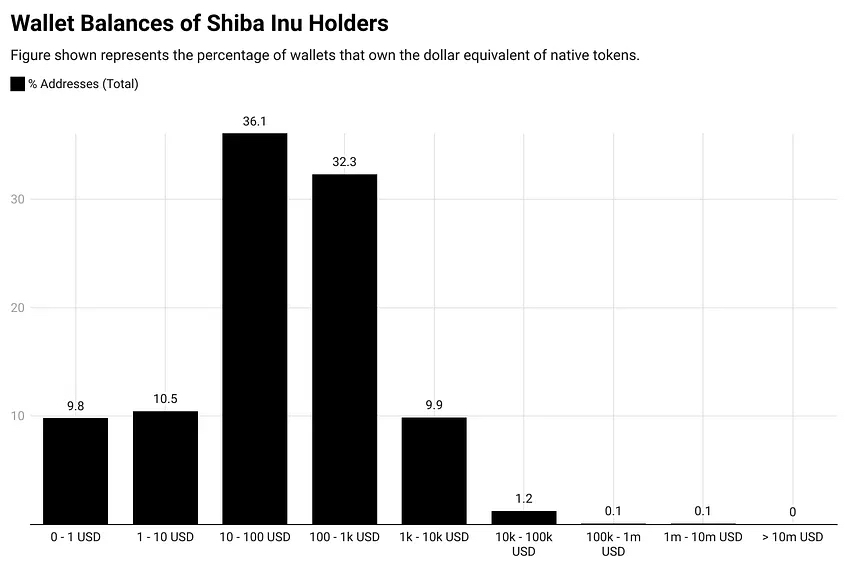
image description
Data from IntoTheBlock.
But new meme projects rarely pay off big on small investments. The biggest return on a six-figure investment I’ve seen from PEPE’s recent rally was $100,000 doubling to $1 million in three weeks.
I took a sample of the 100 wallets that achieved the highest yield and plotted the initial capital they deployed. Out of the 100 wallets, only 3 had more than $10,000 in funds. Most investors who make huge returns are those who invest small sums.
There are two possibilities for these data:
Memecoin provides a way for smaller investors to earn huge returns (by investing early);
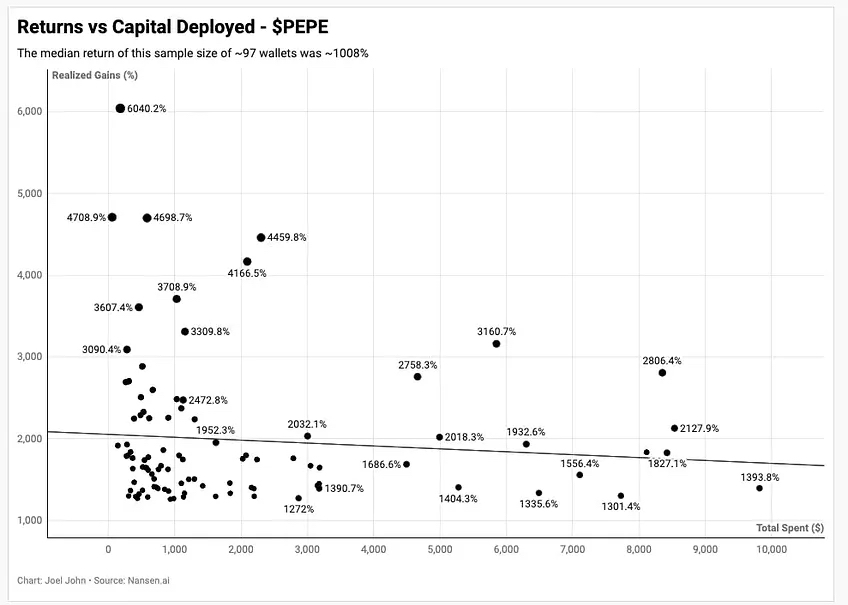
Or these are often insider wallets who were involved in the Ponzi scheme earlier than anyone else.
Here’s a summary of what we’ve seen so far with Memecoins:
As long as large exchanges support it, Meme assets can become "justifiable" financial products;
A small number of early entrants with small capital, the key to their huge returns is to "be one step ahead of others";
Most investors invest under $1000;
Meme assets are similar to Ponzi schemes in that they can perish quickly if the inflow of liquidity from buyers stops. Exchanges solve this problem.
How to correctly view Meme currency?

image description
Here is a screenshot of me searching for Meme coins from Youtube.

People are often optimistic about the world. This is because we believe that as long as we remain optimistic, all will be well. This is often referred to as the "principle of blind optimism." When retail investors follow suit, they often assume that other investors have thoroughly investigated the project.
Many crypto-native users measure their wealth in Bitcoin or Ethereum. To outperform your peers in the market, you need to take more risks. In times of low volatility, even leveraged trading may not necessarily generate the returns traders are looking for. As a result, they are taking higher and higher risks on "new types of assets", thinking that most of these assets will go to zero, and some of them will help them generate huge returns.
As Memecoin has less and less influence in the market, its volatility has started to mimic that of other tokens. In the chart above, two early meme coins, ELON and Shib, started to have similar volatility to Bitcoin. Big money managers also have a tendency to make riskier bets and hold on to them. Early adopter fund managers are also better at hedging and exiting cryptocurrencies during bull and bear cycles. This is not much different from retail investors, who just want to catch a meme coin craze as early as possible.Meme currency is not subject to evaluation kidnapping, but it will last forever because of faith. The tools to issue and trade them can be found with just a few mouse clicks. As long as community faith holds, we will see a surge in speculation surrounding these assets. In fact, regulators could play a role by requiring exchanges to create a framework that dictates the criteria for listing Memecoins. But any framework from regulators means little if liquidity moves to decentralized exchanges. The most extreme cases are like the sanctions against Tornado Cash.
The problem we have as an industry is that the same people who (pretend to) make cool stuff are also (often) peddling these crap projects. When the market worships the "earth dog project" and requires supervision at the same time, it is difficult to pay attention to the needs of users.secondary title



